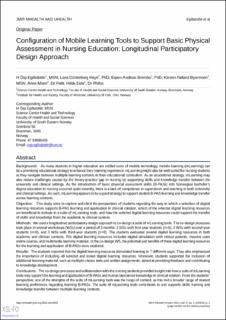| dc.contributor.author | Egilsdottir, H. Ösp | |
| dc.contributor.author | Heyn, Lena | |
| dc.contributor.author | Brembo, Espen Andreas | |
| dc.contributor.author | Byermoen, Kirsten Røland | |
| dc.contributor.author | Moen, Anne | |
| dc.contributor.author | Eide, Hilde | |
| dc.date.accessioned | 2022-02-14T13:22:56Z | |
| dc.date.available | 2022-02-14T13:22:56Z | |
| dc.date.created | 2021-03-11T20:00:08Z | |
| dc.date.issued | 2021 | |
| dc.identifier.citation | Egilsdottir, H. Ö., Heyn, L. G., Brembo, E. A., Byermoen, K. R., Moen, A. & Eide, H. (2021). Configuration of Mobile Learning Tools to Support Basic Physical Assessment in Nursing Education: Longitudinal Participatory Design Approach. JMIR Mhealth Uhealth, 9(1), Artikkel e22633. | en_US |
| dc.identifier.issn | 2291-5222 | |
| dc.identifier.uri | https://hdl.handle.net/11250/2978843 | |
| dc.description.abstract | Background: As many students in higher education are skilled users of mobile technology, mobile learning (mLearning) can be a promising educational strategy to enhance their learning experience. mLearning might also be well suited for nursing students as they navigate between multiple learning contexts in their educational curriculum. As an educational strategy, mLearning may also reduce challenges caused by the theory-practice gap in nursing by supporting skills and knowledge transfer between the university and clinical settings. As the introduction of basic physical assessment skills (B-PASs) into Norwegian bachelor’s degree education in nursing occurred quite recently, there is a lack of competence in supervision and teaching in both university and clinical settings. As such, mLearning appears to be a good strategy to support student B-PAS learning and knowledge transfer across learning contexts.
Objective: This study aims to explore and elicit the perspectives of students regarding the way in which a selection of digital learning resources supports B-PAS learning and application in clinical rotation, which of the selected digital learning resources are beneficial to include in a suite of mLearning tools, and how the selected digital learning resources could support the transfer of skills and knowledge from the academic to clinical context.
Methods: We used a longitudinal participatory design approach to co-design a suite of mLearning tools. The co-design processes took place in several workshops (WSs) over a period of 3 months: 2 WSs with first-year students (n=6), 3 WSs with second-year students (n=6), and 3 WSs with third-year students (n=8). The students evaluated several digital learning resources in both academic and clinical contexts. The digital learning resources included digital simulation with virtual patients, massive open online courses, and multimedia learning material. In the co-design WS, the potential and benefits of these digital learning resources for the learning and application of B-PASs were explored.
Results: The students reported that the digital learning resources stimulated learning in 7 different ways. They also emphasized the importance of including all selected and tested digital learning resources. Moreover, students supported the inclusion of additional learning material, such as multiple-choice tests and written assignments, aimed at providing feedback and contributing to knowledge development.
Conclusions: The co-design processes and collaboration with the nursing students provided insight into how a suite of mLearning tools may support the learning and application of B-PASs and human bioscience knowledge in clinical rotation. From the students’ perspective, one of the strengths of the suite of mLearning tools was the range of content, as this met a broader range of student learning preferences regarding learning B-PASs. The suite of mLearning tools contributes to and supports skills training and knowledge transfer between multiple learning contexts. | en_US |
| dc.language.iso | eng | en_US |
| dc.rights | Navngivelse 4.0 Internasjonal | * |
| dc.rights.uri | http://creativecommons.org/licenses/by/4.0/deed.no | * |
| dc.title | Configuration of Mobile Learning Tools to Support Basic Physical Assessment in Nursing Education: Longitudinal Participatory Design Approach | en_US |
| dc.type | Peer reviewed | en_US |
| dc.type | Journal article | en_US |
| dc.description.version | publishedVersion | en_US |
| dc.rights.holder | © H Ösp Egilsdottir, Lena Günterberg Heyn, Espen Andreas Brembo, Kirsten Røland Byermoen, Anne Moen, Hilde Eide. | en_US |
| dc.source.volume | 9 | en_US |
| dc.source.journal | JMIR mhealth and uhealth | en_US |
| dc.source.issue | 1 | en_US |
| dc.identifier.doi | https://doi.org/10.2196/22633 | |
| dc.identifier.cristin | 1897435 | |
| dc.source.articlenumber | e22633 | en_US |
| cristin.ispublished | true | |
| cristin.fulltext | original | |
| cristin.qualitycode | 1 | |

